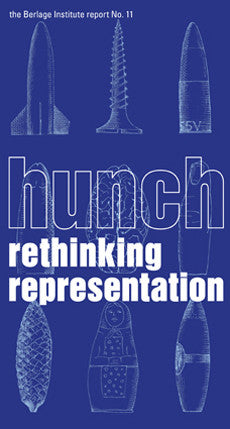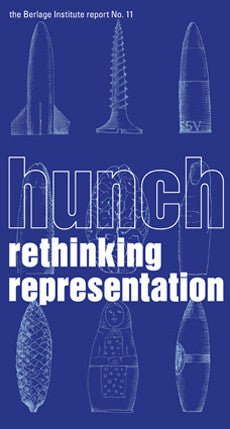Your cart is currently empty!
Architecture
HUNCH 11
+++Rethinking Representation+++
+++Penelope Dean [ed.]+++
978-90-78525-02-8
NL ontwerp [Nandan Lemmers]
176
30 x 16.5
Paperback
English
Contributions by Peter Eisenman, R.E. Somol, Ben van Berkel, Caroline Bos, Madelon Vriesendorp, Charles Jencks, John McMorrough, Penelope Dean, Jeffrey Kipnis, Roemer van Toorn.
HUNCH is a publication of the Berlage Institute, International Postgraduate Laboratory of Architecture, Rotterdam, The Netherlands.
The Berlage Institute Report focusses on the changing profession of architecture/ urbanism and its intersection with contemporary culture. Hunch aims to break down boundaries between architecture and other disciplines, between popular and academic, between 'students' and professionals. It presents the research pursued at the Institute, along with special events, interviews, and the work of visiting lecturers and guest -professors.
From issue nr. 12, HUNCH is published by NAi Publishers, Rotterdam.
Peter Eisenman begins the anthology with an essay outlining his move away from the 'index' toward the 'post-indexical,' or the production of 'figures,' which he finds necessary for today's revised subjects and readers. In a reply to Eisenman's question 'How do you teach green dots?' R. E. Somol puts forward the case for performative architecture, graphic expediency, and the logo. Ben van Berkel and Caroline Bos revisit the role of image and offer the alternate concept of “after-image” as a disciplinary means for architecture to continue its function as art.
In an essay excerpted from his recent book accompanied by the drawings of Madelon Vrisendorp, Charles Jencks lays out the case for the iconic building. John McMorrough historically recalls the architectural coverage of paint through 1960s Supergraphics.
Penelope Dean compares two Alessi Tea and Coffee moments, exposing emblematic episodes in the mobile relationships between architecture and design, representation and discipline.
Jeffrey Kipnis returns to the role of the diagram and its effect of re-origination as the basis for all medium specificity.
Roemer van Toorn defines a 'politics of aesthetics' through the work of Gerrit Rietveld and Wiel Arets Architects.
Sylvia Lavin calls for a shift away from representation and a return to building, promoting the 'pet rock' (a novel object) as a viable analogy for the return to practice. Finally, in the closing essay, Stan Allen discards contemporary discussions of the critical and projective, representation and performance, to state that one's focus can be on practices themselves, in other words on doing.
Despite the various positions and arguments implied in this issue HUNCH 11 stands as a demonstration of the topic's ongoing resilience and centrality to architectural discourse.
This eleventh edition of HUNCH offers a list of representational labels spanning from species (figure, logo, image, icon, diagram) to techniques (application, enlargement) to activities (practice, politics and work).
Rethinking Representation
€15.00
HUNCH 11
Rethinking Representation
€15.00
Architecture / Bookazines / Series / Theory
978-90-78525-02-8
NL ontwerp [Nandan Lemmers]
176
30 x 16.5
Paperback
English
Contributions by Peter Eisenman, R.E. Somol, Ben van Berkel, Caroline Bos, Madelon Vriesendorp, Charles Jencks, John McMorrough, Penelope Dean, Jeffrey Kipnis, Roemer van Toorn.
HUNCH is a publication of the Berlage Institute, International Postgraduate Laboratory of Architecture, Rotterdam, The Netherlands.
The Berlage Institute Report focusses on the changing profession of architecture/ urbanism and its intersection with contemporary culture. Hunch aims to break down boundaries between architecture and other disciplines, between popular and academic, between 'students' and professionals. It presents the research pursued at the Institute, along with special events, interviews, and the work of visiting lecturers and guest -professors.
From issue nr. 12, HUNCH is published by NAi Publishers, Rotterdam.
Peter Eisenman begins the anthology with an essay outlining his move away from the 'index' toward the 'post-indexical,' or the production of 'figures,' which he finds necessary for today's revised subjects and readers. In a reply to Eisenman's question 'How do you teach green dots?' R. E. Somol puts forward the case for performative architecture, graphic expediency, and the logo. Ben van Berkel and Caroline Bos revisit the role of image and offer the alternate concept of “after-image” as a disciplinary means for architecture to continue its function as art.
In an essay excerpted from his recent book accompanied by the drawings of Madelon Vrisendorp, Charles Jencks lays out the case for the iconic building. John McMorrough historically recalls the architectural coverage of paint through 1960s Supergraphics.
Penelope Dean compares two Alessi Tea and Coffee moments, exposing emblematic episodes in the mobile relationships between architecture and design, representation and discipline.
Jeffrey Kipnis returns to the role of the diagram and its effect of re-origination as the basis for all medium specificity.
Roemer van Toorn defines a 'politics of aesthetics' through the work of Gerrit Rietveld and Wiel Arets Architects.
Sylvia Lavin calls for a shift away from representation and a return to building, promoting the 'pet rock' (a novel object) as a viable analogy for the return to practice. Finally, in the closing essay, Stan Allen discards contemporary discussions of the critical and projective, representation and performance, to state that one's focus can be on practices themselves, in other words on doing.
Despite the various positions and arguments implied in this issue HUNCH 11 stands as a demonstration of the topic's ongoing resilience and centrality to architectural discourse.
This eleventh edition of HUNCH offers a list of representational labels spanning from species (figure, logo, image, icon, diagram) to techniques (application, enlargement) to activities (practice, politics and work).



